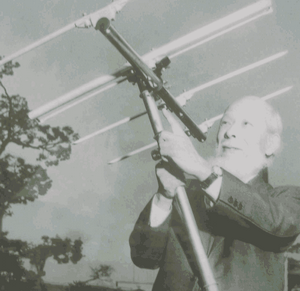Professor Hidetsugu Yagi was born in year 19 of the Meiji Era (January 28 1886 to you and I) in Osaka prefecture, Japan. I have been unable to discover anything about his early life but he graduated in engineering from Tokyo Imperial University in 1909.
After graduating he went to Germany, where he continued his education under the direction of Heinricti Barkhausen, inventor of the Barkhausen oscillator.
Yagi’s research in Germany concerned resonant transformers used in wireless systems. The outbreak of the First World War forced his hurried departure, leaving all his experimental data behind. He later published a paper on the theoretical part of this research in the December 1917 Proceedings of the Institute of Radio Engineers.
Yagi had fled Germany to Great Britain where he studied with John A. Fleming until 1916. Before returning to Japan, Yagi visited the United States and spent some time at Harvard University with George W. Pierce. Yagi then began his teaching career at Tohoku Imperial University, which awarded him a doctorate in engineering in 1919.
At Tohoku University, Yagi initiated a research program in radio-electronics, drawing on the knowledge that he had learned with Barkhausen, Fleming, and Pierce. Other members of the faculty and advanced students, including Okabe and Shintaro Uda, became participants in a collective research effort.
A perceived need for better communication between islands and with ships led them to focus on short wave communication with directive antennas. The Yagi group received financial support for the research from a private foundation in Sendai.
In 1925 Yagi and Uda published their first report on the wave projector antenna in a Japanese publication. In the paper, they discussed the design and performance of a directive antenna that they called a “wave projector” or “wave canal” and which had been developed at the University.
The antenna employed a number of parasitic elements called directors and reflectors and would come to be known as the Yagi antenna or (as it should properly be called) Yagi-Uda antenna.
Yagi applied for patents on the new antenna both in Japan and the United States. His Japanese patent was issued in 1925 and the U.S. patent was issued in 1932 and assigned to the Radio Corporation of America.
Yagi made another visit to the United States in 1928 and gave talks on the Japanese short wave research at Institute of Radio Engineers meetings in several cities and for a group of engineers at General Electric.
His visit stimulated a renewed interest in magnetrons at GE and they developed a 400-MHz magnetron and tested it with a wave projector during the summer of 1928.
The Bureau of Standards engineers also used a Yagi-Uda antenna in an experimental aircraft landing system in 1930.
In 1933 Yagi moved to Osaka Imperial University, the newest and the last Imperial University established with the support from the industry rather than the government, as the 1st chair of the physics department in the faculty of science, the director of a laboratory where developmental work on radar took place. Yagi promoted pure science and encouraged the younger professors and researchers to pursue fundamental physics rather than applied physics while doing the applied part himself to fulfil the industry’s needs. Also that year the short-wave system developed at Tohoku University was used to establish a government radio telephone link between Sakata and Tobishima Island, a distance of about 40 km.
In 1939 he was made Dean of the Faculty of Science at the Osaka Imperial University. In 1944 he became President of the Technology Institute of the Cabinet.
Yagi served as a Civilian Consultant on radar and communication to the Japanese military during World War II. Unfortunately his home, library and most of his personal papers were lost during a bombing raid in April 1945.
Soon after the end of the war he was interviewed by Roger I. Wilkinson, William R. Hewlett and others concerning Japanese developments during the war. In these interviews Yagi expressed frustration over the poor communication and cooperation between the military services and civilian experts.
Gentai Sato, who studied under Yagi, wrote about the surprise to the Japanese when they captured British radar systems equipped with Yagi antennas and a document on Yagi arrays found when Singapore was taken. Sato also noted the irony of the American use of Yagi antennas to determine the height of the explosion of the atomic bombs dropped on Japan.
After the war Yagi served as a consultant on the technological rehabilitation of Japan and assisted in the formulation of television standards. In 1946 he was installed as the 4th President of Osaka Imperial University, and was also President of Japan Amateur Radio League (JARL). He also served as president of the Yagi Antenna Company and was awarded Japan’s Order of Cultural Merit in 1956. He died on January 19 1976, just 9 days short of his 90th birthday.
Yagi was an excellent manager and producer of science, though his methods were, sometimes, unorthodox. It is reported that Professor Yagi had a sharp tongue and encouraged Dr. Hideki Yukawa in very special way with the bitter words “We originally planned to employ Dr. Shinnichiro Tomonaga. However since your elder brother begged us to employ you, we recruited you instead. Please do not make us disappointed. Work harder than Dr. Tomonaga”. Shortly afterwards Dr. Yukawa published his first paper which later brought him the 1st Nobel Prize in Japan. It is believed that the words of Professor Yagi urged Dr. Yukawa to publish his MESON theory although nobody knows what really happened between Professor Yagi and Dr. Yukawa.
When Shintaro Uda visited the United States in 1951 he expressed astonishment at the ubiquity of the Yagi-Uda antennas used as home television antennas.



Gentai Sato should be Gentei Sato. Please correct!